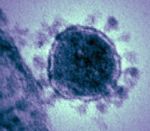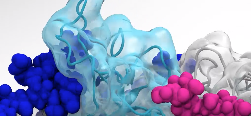SARS-CoV-2 spike protein priming by furin
From Proteopedia
|
Coronavirus (MERS). Transmission electron micrograph, artificially colored (cropped from NIAID public domain). |
Many copies of the spike protein of the coronavirus that causes COVID-19 are seen, in the electron microscope, sticking out from the surface of the virion (virus particle), making it look somewhat like a crown -- hence the name coronavirus[1]. The spike protein is called protein S of the SARS-CoV-2 virus (see SARS-CoV-2 protein S). The spike protein plays a central role in binding to host cells, and getting the RNA genes of the virus into the cell, initiating infection. Thus, knowledge of its protein molecular structure and function is crucial to developing effective therapies and vaccines. In December, 2020, a mutant lineage suspected to have a higher transmission rate was reported.
Two Steps: Priming and ActivationSpike protein binds to antiotensin converting enzyme 2 (ACE2) on host cells to initiate entry and infection. Spike protein is initially in a closed conformation in which the receptor binding motif is less accessible. Proteases such as furin, amply expressed in the respiratory tract[2], clip the spike protein, priming or pre-acivating it to undergo a conformational change that extends the receptor binding motif on one chain (here light green), making it more accessible[1]. Binding to ACE2 and a second proteolytic cut, typically by a host cell membrane-bound protease such as transmembrane serine protease 2 (TMPRSS2) activates spike protein for membrane fusion, which inserts the virus genome into the host cell[1]. Below are scenes showing how the closed form of the coronavirus spike protein changes its conformation when it is primed by the human protease furin. Spike protein conformational change when primed by furinThis morph (restore initial scene) shows the transition of SARS-CoV-2 protein S ("spike protein") from closed (6ZGI) to open (6ZGG) conformation induced by proteolytic cleavage by furin[3]. The transition probably goes only towards the open (extended) conformation, but this animation goes both ways to help visualize the conformational change. (The model is simplified, showing only enlarged alpha carbon atoms, with glycosylation hidden. The model lacks 62 "stem" residues at the C-terminal [narrow] end, and also lacks 65 C-terminal transmembrane and cytoplasmic residues.)
SARS-CoV-2 protein S is a homotrimer composed of three sequence-identical protein chains with a mature length 1,261 amino acids each (total 3,783 amino acids). The host protease furin cuts these chains at the sequence PRRAR[3][4][1] (sequence range 681-685), cutting the chain into fragments S1 and S2. The site cut by furin is part of a 12-amino acid surface loop that could not be resolved in the model, but we can mark the adjacent residues in red. (Click the Toggle Animation button above to restart animation.) Glycan gate
An August, 2021 report[5] concludes that glycans "gate" the opening of the spike protein. This is based on extensive molecular dynamics simulations. Note that glycans (protein glycolylations) are absent from the cryo-EM interactive models shown here in JSmol because their mobility on the spike protein surface leaves no clear density in the EM density maps. The report includes dazzling movies. See especially Supplementary Video 1 and Supplementary Video 4. Priming exposes the ACE2 binding siteThe ACE2 binding site (magenta) on the spike protein consists of 18 spike protein amino acids. This is based on a 2.5 Å resolution crystal structure of the complex (6LZG and see Methods below)[6]. Priming increases exposure of the ACE2 binding site on one of the three spike protein chains. (Click the Toggle Animation button above to restart animation.) Membrane FusionSubsequent activation of the spike protein to induce membrane fusion involves further major conformational changes[7][8]: see SARS-CoV-2 spike protein fusion transformation.
|
| ||||||||||||||
Movies for Slides
The movie at right (a multi-GIF, not interactive) can be dropped into a slide (Powerpoint, slides.google.com, libre office, etc.). It will animate when the slide is projected ("slide show" mode). As above: each chain of the homo-trimer is a different color; ACE2 binding site; furin cleavage site. To DOWNLOAD these files, right click, then save link as:
- 450 pixels, HIGH RESOLUTION, 6.3 MB (not shown).
- 300 pixels (low resolution, 2.8 MB) shown at right.
Please credit Proteopedia.Org in accord with our license, and Wrobel and coworkers[3] for their cryo-EM structures.
See Also
- SARS-CoV-2 spike protein fusion transformation
- SARS-CoV-2 protein S
- Spike protein
- Coronavirus Disease 2019 (COVID-19)
- Prefusion 2019-nCoV spike glycoprotein with a single receptor-binding domain up about 6vsb
Methods
Structures Chosen
6ZGG and 6ZGI by Wrobel et al.[3] were chosen because they have substantially fewer missing amino acids than do the structures by Walls et al.[2] released several months earlier (6vxx and 6vyb). The two closed conformations determined by Wrobel et al.[3] (6zge and 6zgi) are nearly identical: RMSD for a structural alignment of 3,294 alpha carbons is 0.29 Å.
Alignment and Morphing
6ZGG (an open conformation) was aligned with 6ZGI (a closed conformation) using the Iterative Magic Fit of Swiss-PDB-Viewer. This aligned 1,828 alpha carbons (mainly the core of the structure, regions S2) with RMSD 1.34 Å. The closed model was morphed (linear interpolation) to the open model using the server provided by Karsten Theis, requesting 8 intermediate frames. The resulting 10-frame PDB file was loaded into the Jmol Java application. The alpha carbons were selected ("select *.ca") and written into a separate file, which was uploaded to Proteopedia for use in the above morph scenes: Image:Morf-6zgi-to-6zgg-alpha-carbons-only.pdb.
ACE2 Binding Site
6LZG is a 2.5 Å crystal structure of the receptor-binding domain of spike protein bound to ACE2. FirstGlance in Jmol reports that its Rfree is much better than average at this resolution. The Contacts and Non-Covalent Interactions tool in FirstGlance in Jmol identifies all the likely interactions between ACE2 and the spike protein. The interacting spike protein atoms are:
- 1 salt bridge (Ly2417 to Asp30 in ACE2).
- No cation-pi interactions.
- 25 spike protein atoms are in putative hydrogen bonds with ACE2 atoms (oxygens or nitrogens within 3.5 Å of each other).
- 6 spike protein atoms are water-bridged to ACE2 atoms.
- 32 spike protein atoms are in putative van der Waals interactions with ACE2 atoms (carbons within 4.0 Å of each other).
18 spike protein amino acids are involved in these interactions. Their alpha carbons are selected by this Jmol command script:
- select *.ca and (lys417,gly446,tyr449,leu455,phe456)
- select selected or (*.ca and (ala475, glu484, phe486, asn487, tyr489))
- select selected or (*.ca and (gln493, gly496, (gln498 and conformation=1), thr500, asn501))
- select selected or (*.ca and (gly502, tyr505, gln506))
- color magenta
References
- ↑ 1.0 1.1 1.2 1.3 Pillay TS. Gene of the month: the 2019-nCoV/SARS-CoV-2 novel coronavirus spike protein. J Clin Pathol. 2020 Jul;73(7):366-369. doi: 10.1136/jclinpath-2020-206658. Epub, 2020 May 6. PMID:32376714 doi:http://dx.doi.org/10.1136/jclinpath-2020-206658
- ↑ 2.0 2.1 Walls AC, Park YJ, Tortorici MA, Wall A, McGuire AT, Veesler D. Structure, Function, and Antigenicity of the SARS-CoV-2 Spike Glycoprotein. Cell. 2020 Mar 6. pii: S0092-8674(20)30262-2. doi: 10.1016/j.cell.2020.02.058. PMID:32155444 doi:http://dx.doi.org/10.1016/j.cell.2020.02.058
- ↑ 3.0 3.1 3.2 3.3 3.4 Wrobel AG, Benton DJ, Xu P, Roustan C, Martin SR, Rosenthal PB, Skehel JJ, Gamblin SJ. SARS-CoV-2 and bat RaTG13 spike glycoprotein structures inform on virus evolution and furin-cleavage effects. Nat Struct Mol Biol. 2020 Jul 9. pii: 10.1038/s41594-020-0468-7. doi:, 10.1038/s41594-020-0468-7. PMID:32647346 doi:http://dx.doi.org/10.1038/s41594-020-0468-7
- ↑ Thomas G. Furin at the cutting edge: from protein traffic to embryogenesis and disease. Nat Rev Mol Cell Biol. 2002 Oct;3(10):753-66. doi: 10.1038/nrm934. PMID:12360192 doi:http://dx.doi.org/10.1038/nrm934
- ↑ 5.0 5.1 Sztain T, Ahn SH, Bogetti AT, Casalino L, Goldsmith JA, Seitz E, McCool RS, Kearns FL, Acosta-Reyes F, Maji S, Mashayekhi G, McCammon JA, Ourmazd A, Frank J, McLellan JS, Chong LT, Amaro RE. A glycan gate controls opening of the SARS-CoV-2 spike protein. Nat Chem. 2021 Aug 19. pii: 10.1038/s41557-021-00758-3. doi:, 10.1038/s41557-021-00758-3. PMID:34413500 doi:http://dx.doi.org/10.1038/s41557-021-00758-3
- ↑ Wang Q, Zhang Y, Wu L, Niu S, Song C, Zhang Z, Lu G, Qiao C, Hu Y, Yuen KY, Wang Q, Zhou H, Yan J, Qi J. Structural and Functional Basis of SARS-CoV-2 Entry by Using Human ACE2. Cell. 2020 Apr 7. pii: S0092-8674(20)30338-X. doi: 10.1016/j.cell.2020.03.045. PMID:32275855 doi:http://dx.doi.org/10.1016/j.cell.2020.03.045
- ↑ Fan X, Cao D, Kong L, Zhang X. Cryo-EM analysis of the post-fusion structure of the SARS-CoV spike glycoprotein. Nat Commun. 2020 Jul 17;11(1):3618. doi: 10.1038/s41467-020-17371-6. PMID:32681106 doi:http://dx.doi.org/10.1038/s41467-020-17371-6
- ↑ Cai Y, Zhang J, Xiao T, Peng H, Sterling SM, Walsh RM Jr, Rawson S, Rits-Volloch S, Chen B. Distinct conformational states of SARS-CoV-2 spike protein. Science. 2020 Jul 21. pii: science.abd4251. doi: 10.1126/science.abd4251. PMID:32694201 doi:http://dx.doi.org/10.1126/science.abd4251




